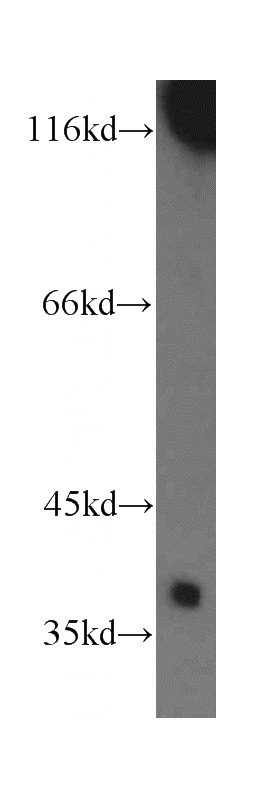-
Product Name
Cathepsin V antibody
- Documents
-
Description
Cathepsin V Rabbit Polyclonal antibody. Positive WB detected in human testis tissue, Jurkat cells, MCF-7 cells, mouse testis tissue. Observed molecular weight by Western-blot: 37-39kd,30kd
-
Tested applications
ELISA, WB
-
Species reactivity
Human,Mouse,Rat; other species not tested.
-
Alternative names
cathepsin L2 antibody; Cathepsin U antibody; Cathepsin V antibody; CATL2 antibody; CTSL2 antibody; CTSU antibody; CTSV antibody
-
Isotype
Rabbit IgG
-
Preparation
This antibody was obtained by immunization of Cathepsin V recombinant protein (Accession Number: NM_001333). Purification method: Antigen affinity purified.
-
Clonality
Polyclonal
-
Formulation
PBS with 0.02% sodium azide and 50% glycerol pH 7.3.
-
Storage instructions
Store at -20℃. DO NOT ALIQUOT
-
Applications
Recommended Dilution:
WB: 1:200-1:2000
-
Validations

human testis tissue were subjected to SDS PAGE followed by western blot with Catalog No:108894(CTSL2 antibody) at dilution of 1:800
-
Background
Cathepsin V is a lysosomal cysteine protease which has an important role in corneal physiology.Cathepsin V was found to be differentially expressed in relation to pigmentary skin backgrounds, and was about 7.5-folds higher in keratinocytes from lightly pigmented, relative to darkly pigmented skins. It is expressed in primary keratinocytes, melanocytes, and HaCaT keratinocytes, but not in primary fibroblasts. The purified cathepsin L2 was a high molecular weight proteinase of about 78 kDa, but it was unstable to SDS and reducing conditions, which dissociated parts of the proteinase into 66 kDa, 31 kDa and 26 kDa fragments(Food Chemistry,Volume11,Issue4,879-886) and it can form a complex of 70 kDa with an unidentified subunit(PMID:1930136).
Related Products / Services
Please note: All products are "FOR RESEARCH USE ONLY AND ARE NOT INTENDED FOR DIAGNOSTIC OR THERAPEUTIC USE"
